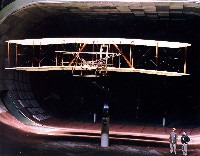Recreating the Wright Stuff

 Full scale replica of the 1903 Wright Flyer in a 40 foot by 80 foot wind-tunnel. |
A full-scale replica of the historic 1903 Wright Flyer was constructed and delivered to NASA's Ames Research Center at Moffett Field, Calif., for wind-tunnel testing during the spring of 1999. During the tests, engineers studied the biplane's stability, control, and handling at speeds up to 27 knots (30 mph) in the wind tunnel. The data obtained was used to build a second Wright Flyer, which was to be flown flown at Kitty Hawk, N.C., on Dec. 17, 2003, on the 100th anniversary of the first flight. Bad weather prevented pilot Kevin Kochersberger from completing the reenactment.
Constructed by a team of volunteers from the Los Angeles section of the American Institute of Aeronautics and Astronautics (AIAA), using plans provided by the Smithsonian, the replica features a 40-foot, 4-inch wingspan reinforced with piano wire, cotton wing coverings, spruce propellers, and a double rudder. The second Flyer, with some modifications for safety, was built by the team of volunteers from the AIAA.
Although others had created “flying machines” before them that could barely lift off the ground and were incapable of true flight, the Wright brothers painstakingly worked four years to construct the first power-driven, human-carrying craft that was heavier than air and capable of controlled, sustained flight. After many trials and setbacks, the former bicycle mechanics from Dayton, Ohio, flew into history in their double-winged craft on Dec. 17, 1903, with Orville at the controls and Wilbur running alongside him. The era of the air age began, and the world was never the same. Their invention would create a new industry and revolutionize transportation, commerce, and communication throughout the globe.
In December 1998, President Clinton signed into law the Centennial of Flight Commemoration Act, which established a commission to coordinate the celebration in 2003 of the 100th anniversary of the Wright Brothers' first flight.







